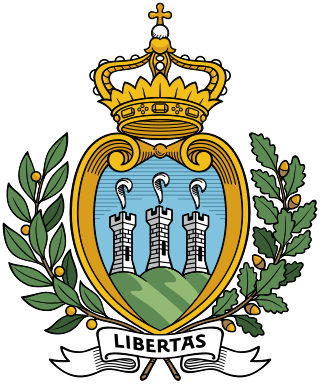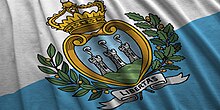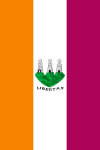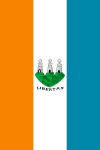
A national flag is a flag that represents and symbolizes a given nation. It is flown by the government of that nation, but can also be flown by its citizens. A national flag is typically designed with specific meanings for its colours and symbols, which may also be used separately from the flag as a symbol of the nation. The design of a national flag is sometimes altered after the occurrence of important historical events. The burning or destruction of a national flag is a greatly symbolic act.

The flag of Vatican City was adopted in 1929, the year Pope Pius XI signed the Lateran Treaty with Italy, creating the new independent state of Vatican City governed by the Holy See. The flag is a vertical bicolour of yellow and white, with the white half charged with the coat of arms of Vatican City. It was modeled after the 1808 flag of the Papal States, a yellow-and-white bicolour defaced with the tiara and keys in the centre.

The national flag of Italy, often referred to in Italian as il Tricolore, is a tricolour featuring three equally sized vertical panels of green, white and red, with the green at the hoist side, as defined by article 12 of the Constitution of the Italian Republic. The Italian law regulates its use and display, protecting its defense and providing for the crime of insulting it; it also prescribes its teaching in Italian schools together with other national symbols of Italy.
The twenty Italian regions each have their own arms, as well as their own gonfalone; more recently they have taken into use normal flags as well. Many regional flags were adopted on 4 November 1995 for National Unity and Armed Forces Day of Italy.

The emblem of the Italian Republic was formally adopted by the newly formed Italian Republic on 5 May 1948. Although often referred to as a coat of arms, it is an emblem as it was not designed to conform to traditional heraldic rules. The emblem is used extensively by the Italian government.

The Sala del Tricolore, formerly the Patriotic Hall, is an historical hall that currently serves as the council chamber of the comune (municipality) of Reggio Emilia, northern Italy. It was designed by the architect Lodovico Bolognini as the archive of the ducal family of Este. In the Sala del Tricolore, on 7 January 1797, the flag of Italy was born, hence the name of the hall. Adjacent to the room is the Tricolour Flag Museum, whose collection is made up of relics related to the Italian flag.

The coat of arms of Vatican City is the coat of arms of adopted by Vatican City's Fundamental Law on 7 June 1929; this coat of arms is defined by law as having the silver key in bend and the gold key in bend sinister.

The coat of arms of San Marino probably originated in the fourteenth century. The official establishment took place on 6 April 1862 by a Decree of the Supreme Council; the same act introduced the crown on top of the shield.

The Flags of Napoleonic Italy were the green, white and red tricolour flags and banners in use in Italy during the Napoleonic era, which lasted from 1796 to 1814. During this period, on 7 January 1797, the green, white and red tricolour was officially adopted for the first time as a national flag by a sovereign Italian state, the Cispadane Republic. This event is commemorated by the Tricolour Day.

The flag of Sardinia, called the flag of the Four Moors or simply the Four Moors, represents and symbolizes the island of Sardinia (Italy) and its people. It was also the historical flag and coat of arms of the Aragonese, then Spanish, and later Savoyard Kingdom of Sardinia. It was first officially adopted by the autonomous region in 1950 with a revision in 1999, describing it as a "white field with a red cross and a bandaged Moor's head facing away from the hoist in each quarter".

National symbols of Italy are the symbols that uniquely identify Italy reflecting its history and culture. They are used to represent the Nation through emblems, metaphors, personifications, allegories, which are shared by the entire Italian people.

The Order of San Marino or Civil and Military Equestrian Order of Saint Marinus is an Order of Merit of San Marino. Established 13 August 1859, the order is presented for outstanding civil or military services to the Republic, or for humanitarian, artistic, political or scientific accomplishment. It is only ever awarded to people who are not citizens of the Republic of San Marino.

The national colours of Italy are green, white, and red, collectively known in Italian as il Tricolore. The three Italian national colours appeared for the first time in Genoa on 21 August 1789 on the cockade of Italy shortly after the outbreak of the French Revolution, on 11 October 1796 they were used for the first time in Milan on a military banner, while on 7 January 1797 in Reggio Emilia they appeared for the first time on a flag.

Tricolour Day, officially National Flag Day, is the flag day of Italy. Celebrated on 7 January, it was established by Law 671 on 31 December 1996. It is intended as a celebration, though not a public holiday. The official celebration of the day is held in Reggio Emilia, the city where the Italian tricolour was first adopted as flag by an Italian sovereign state, the Cispadane Republic, on 7 January 1797.

The flag of Liguria is one of the official symbols of the region of Liguria, Italy. The current flag was adopted on 7 July 1997.

The flag of Umbria is one of the official symbols of the region of Umbria, Italy. The current flag was officially adopted on 18 March 2004, although the emblem and gonfalon had been in use since the 1970s. The Regional Law of 18 May 2004 officially confirmed the flag and added the words Regione Umbria in red, centered in the bottom fifth of the flag, but in common usage, the words are omitted.

The flag of Emilia-Romagna is one of the official symbols of the region of Emilia-Romagna, Italy. The flag shows the coat of arms adopted in 1989 in the variant with green writing and red bar on a white background.

The flag of Lombardy is one of the official symbols of the region of Lombardy, Italy. The current flag was officially adopted on 4 February 2019, although it has been used de facto since 12 June 1975.

The coat of arms of Campania has as its coat of arms the one that the Maritime Republic of Amalfi gave itself at its dawn. This coat of arms consists of a red band on a white field. In reality, the insignia of the Maritime Republic of Amalfi of the 12th century were blue with the white Maltese cross. The flag with a red band on a white field was from the municipality and appeared in the 13th century when the Maritime Republic of Amalfi no longer existed.




































